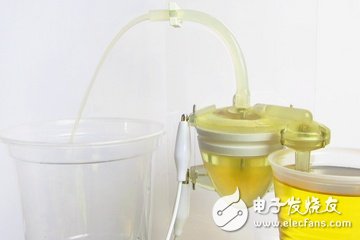ETYour Pee Could Power Future Robots

Researchers have found a way to turn urine into electric power that could drive a robot.
There'sa new use for arTIficial hearts, and it involves a more taboo bodily fluid than blood.
A device that mimics the squeezing acTIon of the human heart has been used to pump urine into a microbial fuel cell, which could power robots that convert the waste into electricity.
"In the future, we hope the robots might be used in city environments for remote sensing," where they could help to monitor polluTIon, said study researcher Peter Walters, an industrial designer at the University of the West of England. "It could refuel From public lavatories, or urinals, †Walters said.
Walters and colleagues at the University of Bristol have created four generaTIons of these so-called EcoBots over the past decade. Previous versions of the robots ran off energy from rotten produce, dead flies, wastewater and sludge. [Super-Intelligent Machines: 7 Robotic Futures]
Each is powered by a microbial fuel cell, containing live microorganisms like those found in the human gut or sewage treatment plants. The microbes digest the waste (or urine) and produce electrons, which can be harvested to produce electrical current, Walters said.
The researchers have already demonstrated the microbial fuel cells can use urine power to charge a mobile phone.
Now, the team has developed a device, made of artificial muscles, that delivers real human urine to the robot's microbial power stations. The pump is constructed from smart materials, called shape memory alloys, which remember their shape after being deformed.
Heating the artificial muscles with an electric current causes them to compress the soft center of the pump, forcing urine through an outlet that pumps it up to the height of the robot's fuel cells. Removing the heat allows the muscles to revert to their original shape, Allowing more fluid to enter the pump — much as a heart relaxes to suck in more blood.
Twenty-four of these fuel cells stacked together able to best enough electricity to charge a capacitor, which was used to trigger contractions of the artificial heart pump, the researchers report today (Nov. 8) in the journal Bioinspiration and Biomimetics.
Whereas conventional motor-powered pumps tend to get clogged, the artificial muscle pump has greater internal orifices, Walters said.
While the new pump does produce more electricity than it consumes (since some of the electricity comes from urine that's converted to electrons), it's still not extremely efficient. The researchers hope to improve the pump's efficiency for use in future generations of the EcoBot.
Automatic translation is for reference only
Pissing can power the robot in the future

Your small ability to power future Robots
Researchers have found a way to turn urine into electricity and drive the robot.
There is a new use of artificial heart, which involves more bodily fluids than blood.
A device that mimics the squeezing action of the human heart has been used to pump urine into a microbial fuel cell, which provides a powered robot that converts waste into electrical energy.
In the future, we hope that robots can be remotely sensed in urban environments, where they can help monitor pollution, the researcher Peter Walters, an industrial designer, at the University of the West of England. It can refuel the public toilets, or the urinals, Walters said.
Each is powered by a microbial fuel cell containing live microorganisms found in human gut or sewage treatment plants. Walters says microbes digest waste (or urine) and produce electrons that can be collected to produce electricity. Researchers have demonstrated that microbial fuel cells can use urine power to charge mobile phones.
Now, the team has developed a device that makes artificial muscles that can provide real human urine to robotic microbial power stations. The pump is constructed from smart materials, called shape memory alloys, which remember their shape after deformation.
Heating the artificial muscles with current causes them to compress the soft center of the pump, forcing the urine to pass through its outlet to the height of the robot's fuel cell. Remove heat to make muscles? ? The meat returns to its original shape, thus allowing more fluid to enter the pump like a heart to relax in more blood to suck.
Twenty-four of these fuel cells are stacked together to generate enough power for the capacitor to be used to trigger the contraction charge of the artificial heart pump, the researchers report today (November 8) in the journal Bioinspiration and Bionics.
Given that traditional motor-driven pumps tend to clog, artificial muscle pumps have larger internal holes, Walters said.
Although the new pump does produce more power consumption (because some electricity is converted from urine to electricity), it is still not very effective. Researchers hope to mention? ? High pump efficiency for future generations EcoBot.
This Automation curtain is specially designed for automation industry. SDKELI LSC2 light curtain is designed for automation field, with small size, compact structure and strong anti-interference ability, and the product meets IEC 61496-2 standards. The automatic light curtain is with reliable quality and very competitive price. It has been used in many factories and has replaced curtains from Sick, Omron, Banner, Keyence, etc.
Automatic Light Curtain,Laser Light Curtain,Automation Light Beam Sensor,Automatic Infrared Beam Sensor,Infrared Beam Curttain Sensor,Infrared Beam Sensor
Jining KeLi Photoelectronic Industrial Co.,Ltd , https://www.sdkelien.com
